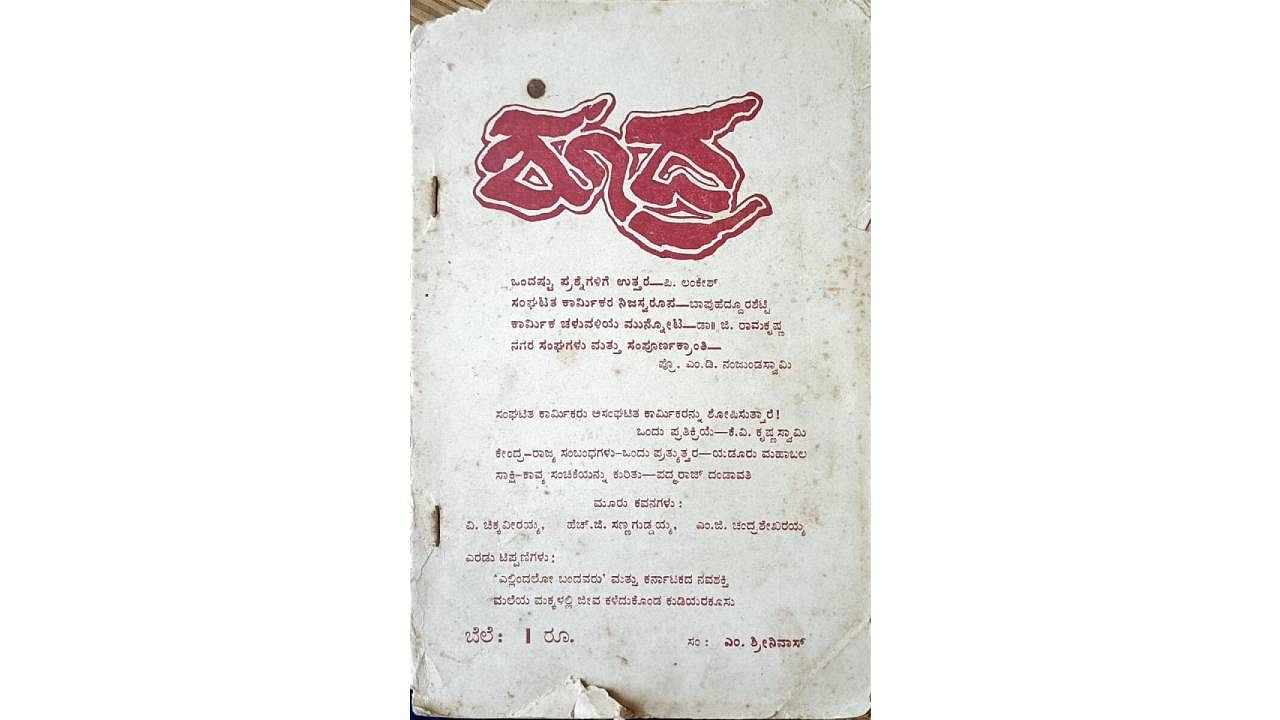
The first issue was released at the historic Jaati Vinasha (Annihilation of Caste) conference held at Mysore in 1973.
Credit: Special Arrangement
It began when M Shrinivas went to M D Nanjundaswamy (popularly known as MDN) founder of the Karnataka unit of the Samajavadi Yuvajana Sabha, with an idea to start a literary-cultural magazine in 1973. Young Shrinivas, a B A Honours graduate, was a familiar figure in the socialist movement.
MDN named the magazine Shudra and designed the cover page. The first issue was released at the historic Jaati Vinasha (Annihilation of Caste) conference held at Mysore in 1973. Shudra continued to be a monthly for more than four decades. The editor came to be known as Shudra Shrinivas, and ‘Shudra’ in short.
Shudra defined itself as a socio-cultural forum of progressive intellectuals of the times. The editor could not preserve copies of the early issues, since the police who arrested Shrinivas during the Emergency in 1975-1976 confiscated his books, including the Shudra issues. The arrest did not unnerve the editor. He continued to publish articles that critiqued the Emergency.
Shudra was one of the very few cultural magazines which published highbrow literary, social and cultural essays. Writers like P Lankesh and D R Nagaraj, historians like S Chandrashekhar and social scientists like M N Shrinivas wrote for Shudra. MDN, who emerged as a farmers’ leader later, introduced Lohiaite thoughts to the Kannada milieu. Marxist
ideologue M K Bhat, socialist leader S Venkatram and economist Bharat Jhunjhunwala enriched Shudra with their polemical essays.
A diverse forum
Shudra was an intimate forum for budding writers. Offbeat stories and poems that were not so welcome in the popular magazines found their place here. Jnanpith awardees and major Kannada poets too, chose this forum.
Shudra was the first to publish the hard-hitting poems of Siddalingaiah, who emerged as a trailblazing Dalit poet of India.
Over decades, Shudra evolved into a forum where knowledge in multiple academic disciplines evolved in Kannada. Shudra motivated Kannada writers, social scientists and cultural theorists to hone their critical skills, and prompted English and Hindi professors to write in Kannada. As and when new literary movements emerged, fresh literary terms and concepts were coined here. Nearly four generations of Kannada writers contributed to Shudra. Special issues of Shudra on Ambedkar, Dalit movements and decentralisation were collectors’ copies.
Any piece in Shudra had a fair chance of reaching those who mattered in Kannada culture for decades. The magazine reached most of the significant Kannada writers, no matter whether they renewed their subscriptions or not. The editor himself would send the issues by post and even deliver them to subscribers on his moped.
Shrinivas ran his own press too, but without much dividends. He toiled hard to raise money for the printing cost at times. Some printers were scared to print Shudra, thanks to its political content during the Emergency. Ila Vijaya, an upright journalist, took up the challenge and printed it in her Ila Mudrana and stood by the editor in moments of crises. An occasional helping hand of friends too took care of the printing sometimes. Shrinivas did not accept government advertisements for years.
The endeavour was but a pure labour of love. Shrinivas carried on smiling, taunting and taunted, swallowing his pride, facing humiliations, and brooding over them or laughing it off, over a mug of beer with friends in the evening.
While Shrinivas is a Lohiaite Socialist, his magazine was quite inclusive. Writers belonging to Navya, Bandaya, Dalit and feminist schools felt at home here. His column Kanasigondu Kannu with the tagline ‘personal letters’ recorded the bizarre experiences of the editor. Shrinivas, in his typical ‘stream of consciousness’ narrative, would reflect on his encounters during his nocturnal wanderings. Highbrow writers took a dig at his jottings, but could not miss reading it!
One thousand copies of Shudra were printed each month. By 1990, the circulation reached 3,000. Having brought out 400 plus issues, the editor called it a day in 2018. Recently, his friends organised the Shudra-50 program, acknowledging the contribution of Shudra in shaping literary culture. H Dandappa, noted Kannada critic, edited a volume titled Shudra Shrinivas: Baduku Baraha which records Shrinivas’ achievements in different genres. His introduction traces the evolution of Shudra as a true cultural companion.
Shrinivas taught at R V high school, Bengaluru, for 15 years and took voluntary retirement.
For nearly 45 years, Shudra fondly nourished the cosy literary culture where shy and serious writers live and thrive. The issues remain excellent reference sources for researchers, and his friends plan to publish selected essays from Shudra in volumes. The contribution of Shudra to literary criticism and cultural theory in Kannada richly deserves prominent pages in the post-independent modern history of Kannada literary culture.